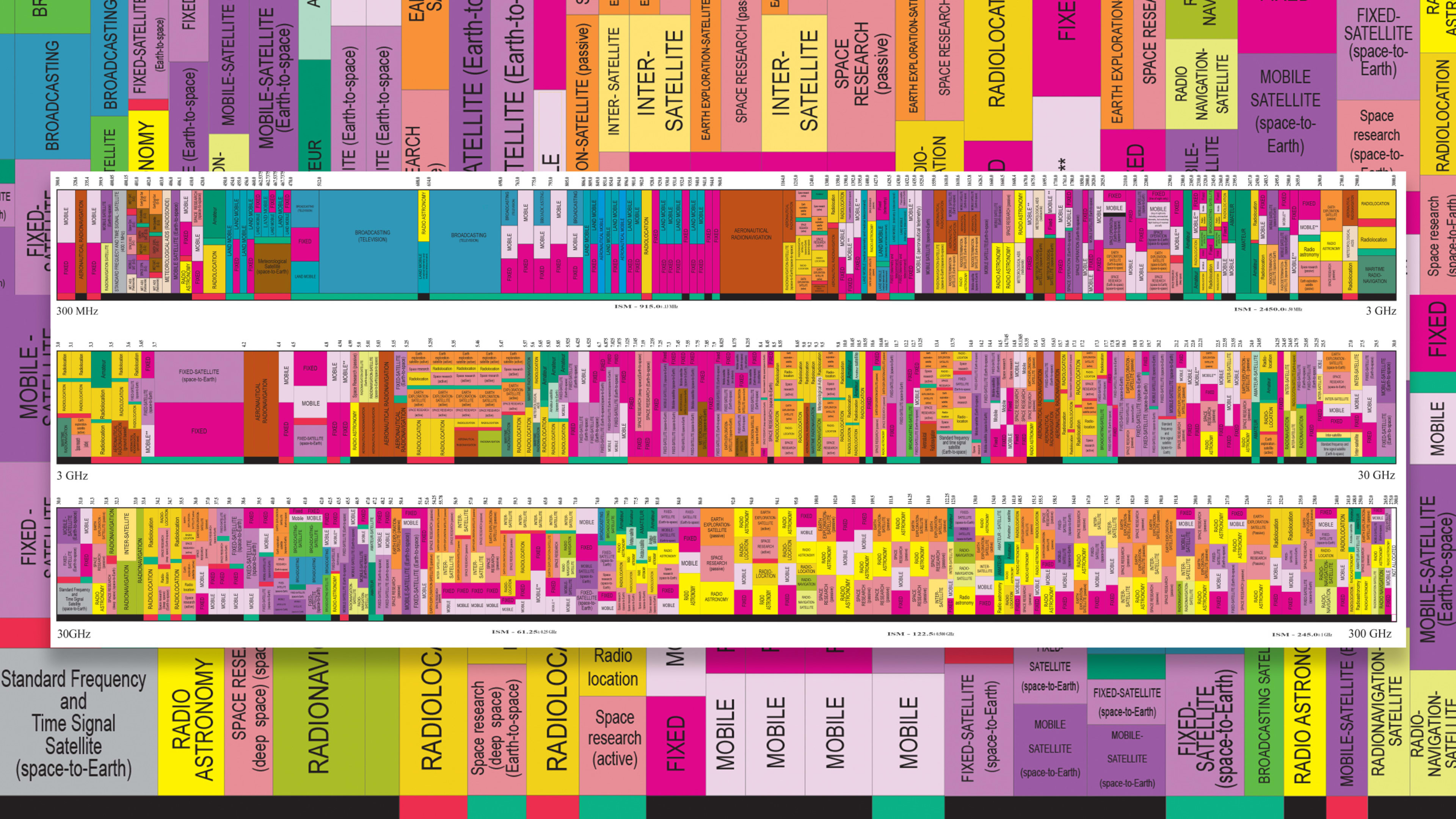Somewhere above you right now, a plane is broadcasting its location, speed, and bearing on 1090 MHz. A geostationary weather satellite 22,000 miles from Earth is transmitting detailed weather maps on 1694.1 MHz. A car driving by your home is transmitting a signal with the pressure readout of one of its tires at 315 MHz. A GPS satellite flying overhead at 8,000 mph is pinging a signal to your phone at 1575.42 MHz. A data buoy bobbing in the Atlantic ocean transmits sea temperature, wave height, and wind speed readings to a National Oceanic and Atmospheric Administration satellite at 401 MHz.
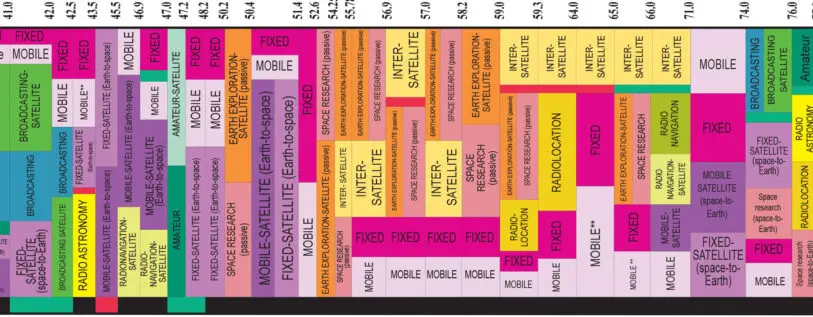
On top of all that, every single mobile device and Wi-Fi router near you blasts out everyone’s internet traffic through the air over radio waves. How the hell are all of these signals getting to the right place intact without stepping all over each other? The answer is a very carefully regulated radio spectrum.
The Federal Communications Commission and the National Telecommunications and Information Administration share the task of managing the allotment of radio frequencies for U.S. airwaves. The NTIA manages all federal radio applications (including military uses); the FCC manages everything else, including state and local government, commercial, and amateur radio use.
The air waves floating across America are sliced up into chunks (some wide, some incredibly narrow) where different services and uses are permitted to broadcast and receive radio signals.

It is an incredibly complex system, so to help with the job of explaining the importance of managing this invisible natural resource, the NTIA publishes a wall chart (which you can order from the Government Publishing Office as a poster for a mere $6 with free shipping!).
Slices of Spectrum
Not all radio applications on this chart are equal. The U.S. government lays claim to a large chunk of America’s radio spectrum for military use, communications, transportation systems, water control satellites, data transmission, and time signals. Commercial broadcast TV signals (yes, they are still out there) and plain old AM and FM radio have a dedicated swath, which provides probably the only true touchpoint in most people’s lives with the various frequencies on the radio spectrum. FM radio is allowed to operate between 88 MHz and 108 MHz, and AM radio operates between 540 kHz and 1700 kHz.
Amateur radio operators (like me, KE3GAN) are granted various slices in which to operate safely, and licenses are granted to all manner of businesses and institutions who use different frequencies for communication of many types. Civil aviation, maritime navigation, satellite communications, radio astronomy, and cellular voice and data all lay claim to the colorful spectrum plots on this chart suited to the demands of their radio applications.
The specifics of what each slice is used for appear in a lengthy document known as the FCC Online Table of Frequency Allocations; it presents a breakdown in table format, which is precise but pretty boring to look at.
The Frequency Allocation Chart uses 33 color-coded categories to visualize the information from the Table of Frequency Allocations in a crazy quilt of blocks spread from 9 kHz (very low frequency) all the way to 300 GHz (extremely high frequency).
A Popular Chart
I spoke with Eric Rosenberg, a telecommunications specialist at NTIA, about the history of the chart, how it’s used, and the challenges of clearly describing the way spectrum is managed.
Rosenberg says a lot of the determinations of what service goes where on the spectrum come down to physics and the environment it will be used in. For example, the military and weather services use a lot of microwave communications (greater than 1 GHz) for specific applications that can’t just be put anywhere on the spectrum. “You can’t just pick up a block and say, ‘Okay, we’re gonna move these radars over here,’” he says.
Rosenberg says the chart is always extremely popular with people who see it for the first time, including lawmakers in Congress. The chart does suffer from scale distortions, not unlike a map that makes certain parts of the Earth appear larger than others.
“When we do the chart, part of the design . . . is to balance the relationship between the services that are being served and the bandwidth that they have. And that is the difficulty that you get to, because . . . the first line of the existing chart . . . traditionally is less bandwidth, which looks like [fewer] services,” Rosenberg explains, adding that if you were able to increase the scale of the bottom third of the chart, the allocations would look quite different. “You would say that the allocations are individually maybe a lot bigger and there are even more services there than you think.”
Unregulated Chaos on the Airwaves
On December 12, 1901, building on the work of other inventors, Italian engineer Guglielmo Marconi received the first transatlantic radio transmission at Signal Hill in St. John’s, Newfoundland. The signal was broadcast from a transmitter in Poldhu, Cornwall, in the U.K.; it consisted of Morse code for the letter S at a frequency estimated to be 850 kHz (in the medium frequency range).
Within a few years, the first voice and sound transmissions had been broadcast, and by 1910, ships carrying 50 or more people were mandated to carry radio communications equipment and a radio operator.
But the airwaves were starting to get crowded, and there were no real rules in place to govern who could broadcast on what frequency. Amateur operators along the coast were prank calling Navy ships at sea and chaos ensued.
Congress had already developed a plan to start regulating the airwaves by issuing licenses when the Titanic sank in April 1912. But the disaster involved some serious miscommunication of wireless transmissions by boats at sea. As the tragedy unfolded, there was concern that the unregulated airwaves were putting lives at risk, and that channels needed to be defined for amateurs and others cleared only for maritime and government use.
This was the goal of the Radio Act of 1912. It restricted all amateur radio operators to a portion of the spectrum and codified various other rules, such as the adoption of an official “signal of distress” which is Morse code for SOS ( …—… ). This was followed by the Radio Act of 1927, which set up the Federal Radio Commission, later becoming the FCC by the sweeping Communications Act of 1934.
Early Attempts to Visualize the Spectrum
Rosenberg of NTIA shared an interesting early attempt at laying out the radio spectrum and how it was being used via vertical columns in a Federal Radio Commission chart dated October 22, 1928. It spanned 10 kHz to 60 MHz. Sections were reserved for amateurs, aviation, government, agriculture, emergency use, and maritime use.
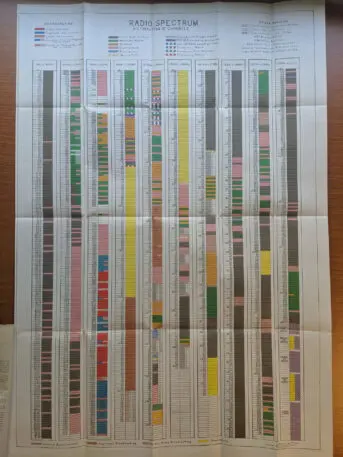
A 1944 educational poster titled the “Chart of Electromagnetic Radiations” was created by the W. M. Welch Scientific Co. It was absolutely crammed with diagrams describing the electromagnetic spectrum as a whole, together with tons of related scientific concepts that included some allocations of radio use. You can find a seriously hi-res copy on the Lawrence Livermore National Laboratory’s Flickr page.
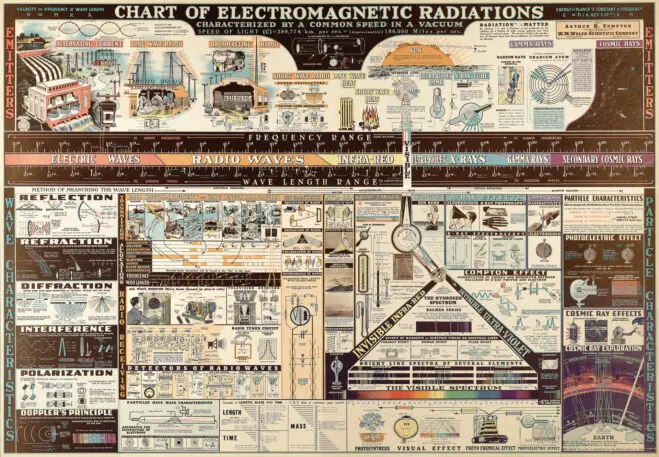
In 1959, RCA created a wall chart of the spectrum, also using a vertical orientation.
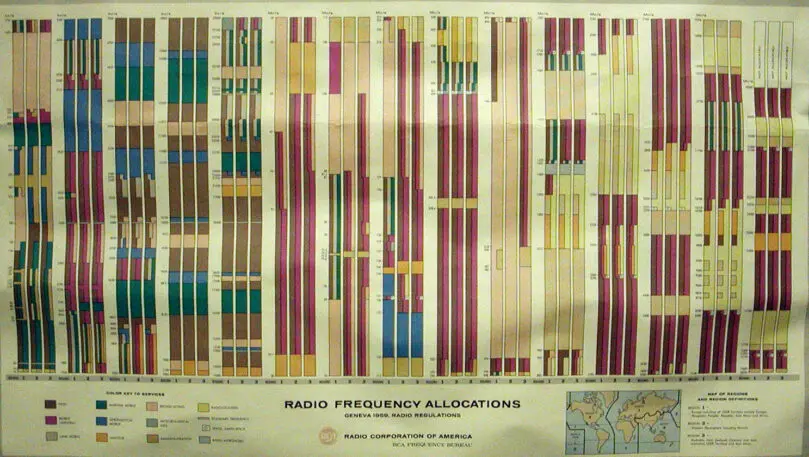
According to Rosenberg, the earliest U.S. government versions of the chart were created in the 1970s by the White House Office of Telecommunications Policy. Thereafter it was updated periodically over 5- to 10-year intervals. Editions of the chart were published in 1987, 1996, and 2003, with the most recent version released in 2016.
“These charts, they are not for planning purposes,” Rosenberg says, noting that they represent merely a snapshot in time. With regard to how much each revision has changed, he says, “The changes are rather subtle, so if you stack them on top of each other, you might not see any differences. And so for that reason it’s a very labor-intensive process.”
Your Country, Your Spectrum
Each country controls how its radio spectrum is allocated, but international coordination is needed, as radio waves don’t care about borders. This coordination is organized by the International Telecommunication Union, an agency of the United Nations. Below are a few examples of how other countries map out their own radio spectrum allocations.
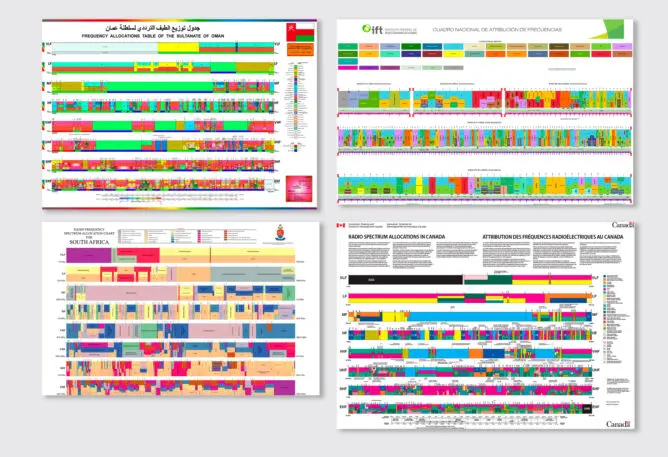
Republished with permission from Beautiful Public Data, a newsletter by Jon Keegan that curates visually interesting data sets collected by local, state, and federal government agencies.
To see more of the tools used to explore this data, read more at Beautiful Public Data. You can subscribe to the newsletter here.
Recognize your brand’s excellence by applying to this year’s Brands That Matter Awards before the early-rate deadline, May 3.
